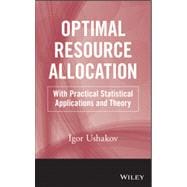
Note: Supplemental materials are not guaranteed with Rental or Used book purchases.
Purchase Benefits
What is included with this book?
IGOR USHAKOV, DrSci, was previously a professor at both The George Washington University and the University of California, San Diego; chair of the Department of Large Scale Systems at the Moscow Institute of Physics and Technology; and a principal engineer at Qualcomm. In addition, he is founder of the International Group on Reliability's Gnedenko Forum and has authored or edited dozens of books and published more than 300 journal papers on reliability engineering, logistics, and quality assurance.
1. BASIC MATHEMATICAL REDUNDANCY MODELS 8
1.1. Types of Models 8
1.2. Non-repairable redundant group with active redundant units 9
1.3. Non-repairable redundant group with standby redundant units 11
1.4. Repairable redundant group with active redundant units 13
1.5. Repairable redundant group with standby redundant units 16
1.6. Multi-level systems and system performance estimation 17
1.7. Brief review of other types of redundancy 18
1.8. Time redundancy 23
1.9. Some additional optimization problems 25
Chronological Bibliography of Main Monographs 26
2. FORMULATION OF THE OPTIMAL REDUNDANCY PROBLEMS 29
2.1. Problems description 29
2.2. Formulation of the optimal redundancy problem with a single restriction 29
2.3. FORMULATION OF OPTIMAL REDUNDANCY PROBLEM WITH MULTIPLE CONSTRAINS 33
2.4. Formulation of multi-criteria optimal redundancy problems 35
Bibliography to Chapter 2 36
3. METHOD OF LAGRANGE MULTIPLIERS 40
Bibliography to Chapter 3 44
4. STEEPEST DESCENT METHOD 45
4.1. The main idea of SDM 45
4.2. Description of the algorithm 46
4.3. The stopping rule 47
4.5. Approximate solution 50
Bibliography to Chapter 452
5. DYNAMIC PROGRAMMING 53
5.1. Bellman’s Algorithm 53
5.2. Kettelle's Algorithm 57
Bibliography to Chapter 5 62
6. UNIVERSAL GENERATING FUNCTIONS 62
6.1. Generating function 62
6.2. Universal GF (U-function) 63
Bibliography to Chapter 6 69
7. GENETIC ALGORITHMS 69
7.1. Introductory 69
7.2. Structure of Steady-state Genetic Algorithms 71
7.3. Related techniques 72
Bibliography to Chapter 773
8. MONTE CARLO SIMULATION 75
8.1. Introductory remarks 75
8.2. Formulation of optimal redundancy problems in statistical terms 75
8.3. Algorithm for Trajectory Generation 75
8.4. Description of the Idea of the Solution 77
8.5. Inverse Optimization Problem 79
8.6. Direct Optimization Problem 86
Bibliography to Chapter 8 89
9. COMMENTS ON CALCULATION METHODS 89
9.1. Comparison of methods 89
9.2. Sensitivity analysis of optimal redundancy solutions 92
10. OPTIMAL REDUNDANCY WITH SEVERAL LIMITING FACTORS 97
10.1. Method of “weighing costs” 97
10.2. Method of Generalized Generating Functions 99
Bibliography to Chapter 10 100
11. Optimal Redundancy in Multistate Systems 101
Bibliography to Chapter 11 112
12. CASE STUDIES 113
A. Spare supply system for worldwide telecommunication system Globalstar 113
B. Optimal capacity distribution of telecommunication backbone network resources 120
C. Optimal Spare Allocation for Mobile Repair Station 123
Bibliography to Chapter 12 126
13. Counter-terrorism: Protection Resources Allocation 127
13.1. Introduction 127
13.2. Verbal description of the problem 127
13.3. Evaluation of expected loss 129
13.4. Algorithm of resources allocation 129
13.5. Branching System Protection 132
13.6. Fictional “Case Study” 138
13.7. Antiterrorism resources allocation under fuzzy subjective estimates 146
The problem of optimal resources allocation for antiterrorism preventive measures is naturally based on subjective estimates made by experts in this field. Relying on expert estimates is inevitable in this case: there is no other possibility to get input data for the system survivability analysis. There is no such phenomenon like “collecting real data”, moreover, there is no “homogenous samples” for consistent statistical analysis of observations, since any case is unique and non-reproducible. Nevertheless, quantitative analysis of necessary level of protection has to be performed 146
What are the subjects of such expertise? It seems to us that they are: 146
Bibliography to Chapter 13 152
About the author 155
The New copy of this book will include any supplemental materials advertised. Please check the title of the book to determine if it should include any access cards, study guides, lab manuals, CDs, etc.
The Used, Rental and eBook copies of this book are not guaranteed to include any supplemental materials. Typically, only the book itself is included. This is true even if the title states it includes any access cards, study guides, lab manuals, CDs, etc.